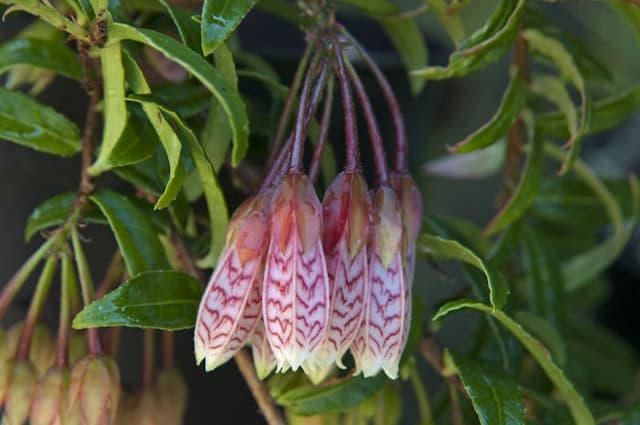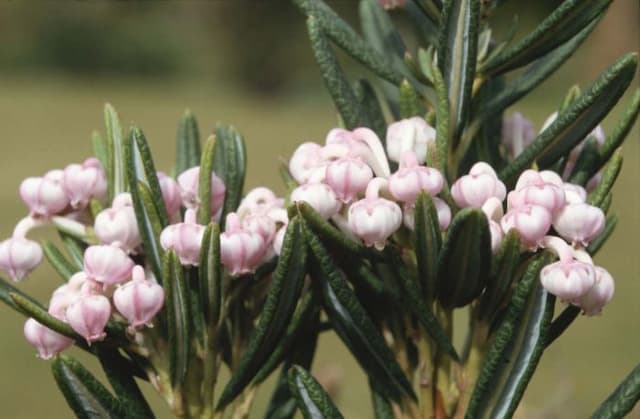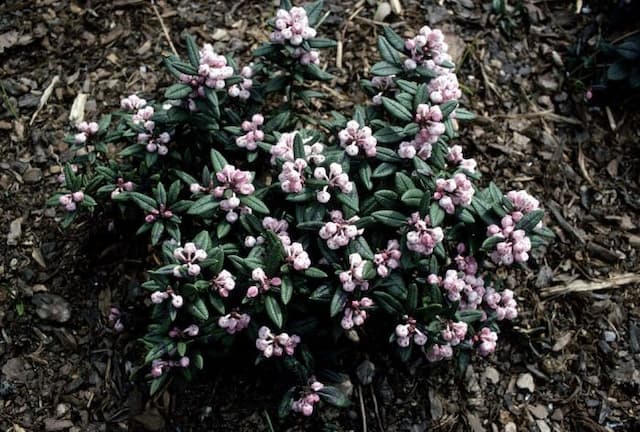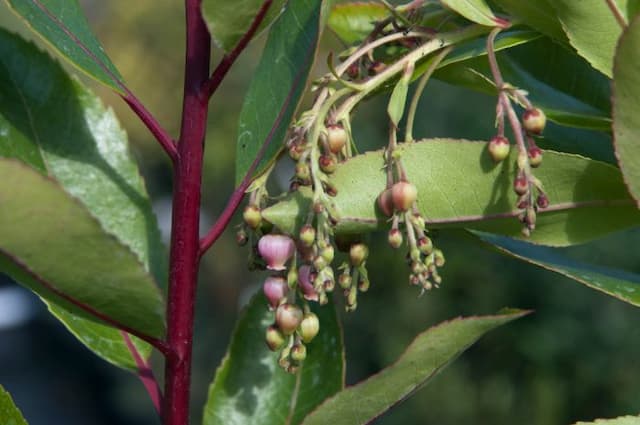Azalea Rhododendron 'Morning Cloud'

ABOUT
Rhododendron 'Morning Cloud' is a stunning plant renowned for its remarkable flowers and foliage. The plant boasts clusters of blossoms that are a harmonious blend of pastel shades, often featuring a soft pink hue edged with a paler pink or white margin. These blooms are trumpet-shaped, a characteristic feature of many rhododendrons, and they come together in large, showy clusters that can create a spectacular floral display during their blooming season. The leaves of the Rhododendron 'Morning Cloud' are leathery and evergreen, providing year-round interest. They have a deep green color and a glossy surface that can appear almost waxy. The foliage has a dense and lush quality, forming a backdrop that further accentuates the beauty of the flowers. Overall, Rhododendron 'Morning Cloud' presents a rounded and bushy appearance, contributing to its popularity in ornamental gardens where it is valued for both its aesthetic appeal and its ability to provide consistent visual interest throughout the year. Its blossoms and foliage make it a focal point when in bloom, and its structure provides a solid foundation for garden design even when the plant is not flowering.
About this plant
 Names
NamesFamily
Ericaceae
Synonyms
Azalea, Rhododendron
Common names
Rhododendron 'Morning Cloud'
 Toxicity
ToxicityTo humans
Rhododendrons, including the 'Morning Cloud' variety, contain toxic compounds called grayanotoxins. If any part of the plant is ingested by humans, it can lead to poisoning. Symptoms of rhododendron poisoning may include vomiting, diarrhea, hypersalivation, weakness, coma, hypotension, bradycardia, and potentially even death, particularly from cardiac effects. Medical attention should be sought immediately if ingestion occurs.
To pets
Rhododendrons, such as the 'Morning Cloud' variety, are toxic to pets as well. The plant contains grayanotoxins which can cause serious health issues if ingested by pets like dogs and cats. Symptoms of toxicity in pets can include vomiting, diarrhea, drooling, weakness, loss of appetite, abdominal pain, abnormal heart rate and rhythm, leg paralysis, and seizures. In severe cases, ingestion can be fatal. Pet owners should seek veterinary care immediately if their pet consumes any part of a rhododendron plant.
 Characteristics
CharacteristicsLife cycle
Perennials
Foliage type
Evergreen
Color of leaves
Green
Flower color
White
Height
6 feet (1.83 meters)
Spread
5 feet (1.52 meters)
Plant type
Shrub
Hardiness zones
5
Native area
Asia
Benefits
 General Benefits
General Benefits- Ornamental Appeal: Rhododendron 'Morning Cloud' is prized for its beautiful flowers and overall aesthetic contribution to gardens.
- Versatility: It can thrive in a variety of soil types when properly conditioned and is suitable for different landscape designs.
- Attracts Pollinators: Bees and butterflies are attracted to the flowers, helping to pollinate the plant and other plants in the area.
- Evergreen Foliage: Provides year-round greenery in the garden, maintaining a constant backdrop of foliage.
- Diverse Habitat: Serves as shelter and food source for various bird species, supporting local biodiversity.
- Low Maintenance: Once established, it requires minimal care beyond occasional pruning and watering during dry spells.
- Seasonal Interest: Offers vibrant blooms in the spring that add seasonal charm and color to garden spaces.
 Medical Properties
Medical PropertiesThis plant is not used for medical purposes.
 Air-purifying Qualities
Air-purifying QualitiesThis plant is not specifically known for air purifying qualities.
 Other Uses
Other Uses- Photography Subjects: The Rhododendron Morning Cloud, with its beautiful clusters of flowers, can be a stunning subject for photographers, particularly in spring when they are in full bloom.
- Textile Dyes: The petals of the Rhododendron Morning Cloud can be boiled to extract natural dyes for coloring fabrics, though this is not a common practice.
- Artistic Inspiration: Artists may use the vivid colors and shapes of the Rhododendron Morning Cloud as inspiration for paintings, drawings, and other art forms.
- Educational Tool: Botany teachers and educators can use the Rhododendron Morning Cloud to teach students about plant biology, pollination, and the life cycle of shrubs.
- Wedding Decor: The attractive flowers of the Rhododendron Morning Cloud can be used in wedding bouquets, centerpieces, and venue decorations.
- Bonsai: With careful pruning and shaping, the Rhododendron Morning Cloud can be grown as a bonsai plant, offering a challenge to horticulture enthusiasts.
- Theme Gardens: The plant can be featured in a themed garden, like a pastel-colored garden, due to its soft pink blossoms.
- Garden Competitions: Rhododendron Morning Cloud can be entered into garden and flower show competitions for its aesthetic appeal.
- Erosion Control: When planted on slopes, the Rhododendron Morning Cloud's root system can help stabilize soil and prevent erosion.
- Culinary Experimentation: In some cultures, flower petals may be used to garnish dishes or infuse desserts with floral notes, but caution is advised as Rhododendrons contain toxic substances.
Interesting Facts
 Feng Shui
Feng ShuiThe Rhododendron is not used in Feng Shui practice.
 Zodiac Sign Compitability
Zodiac Sign CompitabilityThe Rhododendron is not used in astrology practice.
 Plant Symbolism
Plant Symbolism- Warning: Rhododendrons can be toxic when ingested, symbolizing caution or danger.
- Bewitching beauty: The stunning blooms represent the idea that beauty can be mesmerizing but also potentially dangerous.
- Abundance: The plentiful flowers of the Rhododendron signify abundance and wealth.
- Elegance: With its sophisticated look, the plant symbolizes elegance and refined beauty.
- Survival: Rhododendrons are hardy plants capable of surviving in challenging climates, symbolizing hardiness and the ability to overcome obstacles.
- Rejuvenation: The blooming of the Rhododendron signifies new beginnings and the rejuvenation of the spirit.
- Homecoming: In many cultures, they are often given to welcome someone home, representing a safe return.
 Water
WaterAzaleas, including the 'Morning Cloud' variety, prefer consistently moist but well-draining soil. They should be watered thoroughly whenever the top inch of soil feels dry to the touch. Generally, this means watering deeply about once a week, but frequency can vary depending on weather conditions, with more frequent watering necessary in hot, dry spells. When watering azaleas, gently soak the soil all around the root area, providing about one gallon of water per square foot every 7-10 days. Avoid overhead watering to minimize disease risk and don't let the roots stand in water, as this can cause root rot.
 Light
LightAzaleas, like the 'Morning Cloud', thrive in partial shade where they can receive filtered sunlight or some direct morning light. The best spot for these azaleas would be an area that's shielded from harsh afternoon sun, especially in warmer climates. An ideal location would be under the light canopy of larger trees or on the north or east side of a building.
 Temperature
TemperatureThe 'Morning Cloud' azalea does well in a temperate climate and is hardy in USDA zones 5 through 8. This plant can survive minimum temperatures ranging from -20 to -10 degrees Fahrenheit, but it performs best in an environment where the temperature consistently stays between 40 and 80 degrees Fahrenheit. Temperature extremes, both hot and cold, should be avoided to maintain plant health.
 Pruning
PruningPrune azaleas like 'Morning Cloud' immediately after they finish blooming in spring to shape the plant or reduce its size. This timing allows the plant to set buds for next year's flowers. Pruning can also help encourage bushier growth and maintain the plant's health by removing dead or diseased wood. Annual, light pruning is generally sufficient for azaleas, and drastic pruning should be avoided unless the plant is overgrown.
 Cleaning
CleaningAs needed
 Soil
SoilAzaleas prefer a well-draining, acidic soil mix with a pH of 4.5 to 6.0. A mix of peat moss, pine bark, and perlite in equal parts can support healthy growth and flower production for Rhododendron 'Morning Cloud'.
 Repotting
RepottingAzaleas, like Rhododendron 'Morning Cloud', typically require repotting every 2 to 3 years to refresh the soil and provide room for growth. It's best to repot in the early spring before new growth begins.
 Humidity & Misting
Humidity & MistingRhododendron 'Morning Cloud' thrives at a higher humidity level, ideally between 50% to 60%. These plants appreciate a moist environment, which mimics the conditions of their native habitats.
 Suitable locations
Suitable locationsIndoor
Place in bright, indirect light with high humidity and cool temps.
Outdoor
Partial shade, shelter from harsh sun and wind, well-drained, acidic soil.
Hardiness zone
5-8 USDA
 Life cycle
Life cycleThe Rhododendron 'Morning Cloud', also known as Morning Cloud Azalea, begins its life cycle as a seed, typically germinating in a well-drained, acidic soil environment with partial shade. As a seedling, it puts down roots and sprouts its first leaves, gradually maturing into a young plant. Over several years, it will grow into a mature shrub, developing a woody structure and a prolific display of flowers, usually in the spring. After pollination, often by insects, the plant will produce capsules containing numerous seeds, completing its reproductive cycle. Throughout its life, the Morning Cloud Azalea will enter a period of dormancy during the colder winter months, reducing its metabolic activities to conserve energy. This azalea, if properly cared for, can live for many years, sometimes several decades, going through repeated cycles of growth, flowering, and dormancy.
 Propogation
PropogationPropogation time
Spring-Early Summer
The most popular method of propagating Rhododendron 'Morning Cloud' is through semi-hardwood cuttings. This is typically done in the late summer, after the new growth has begun to mature and harden slightly. To start, select healthy, semi-ripe shoots and cut a piece about 4 to 6 inches long, making sure each cutting has several sets of leaves. Remove the lower leaves to create a bare stem which can be dipped in rooting hormone powder to encourage root growth. Plant the cuttings in a well-draining soil mix within a pot or tray, and then provide a humid environment, such as placing a plastic bag loosely over the pot to retain moisture. Keep the soil moist but not saturated, and in a few weeks to months, the cuttings should begin to root. Once rooted, they can be transplanted into individual pots and grown on before planting out.









